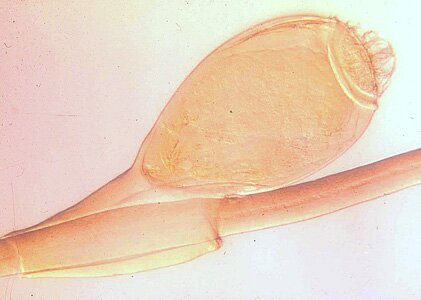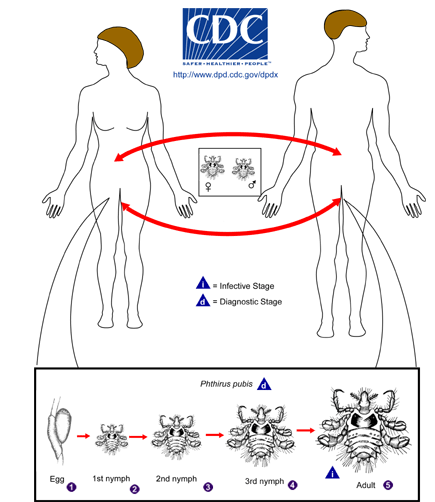Crab-louse (Phthirus pubis)

 Crab-louse (Phthirius pubis). It is white and grey. Its female individuals reach the size of 1,5 – 2,5 mm and male ones – 1mm. The whole body shape is similar to the human louse. Its short torso is wider than its also short abdomen. In natural conditions the growth period lasts about 4 weeks. Females lay about thirty eggs. Their embrional growth lasts 7 – 8 days. If the temperature falls below 20 degrees Centigrade the hatching is stopped. Fertilized females tend to change their location in order to lay eggs in another place. Mature individuals survive outside the host in a humid environment for 40 – 44 hours and in a dry one for about 30 hours. A crab-louse lives in a womb, a groin, an armpit, eyelashes, eyebrows and other hairy parts of a human body. Attached to the bottom of the hair they stay in a particular place for many days sucking blood from time to time. They abandon the host in case of their low physical activity. Females searching for males to copulate travel through the whole body or pass onto another person around. The infection might happen during an intercourse or while sleeping in one bed with an infected person. You can also get infected by wearing the same clothes.
Crab-louse (Phthirius pubis). It is white and grey. Its female individuals reach the size of 1,5 – 2,5 mm and male ones – 1mm. The whole body shape is similar to the human louse. Its short torso is wider than its also short abdomen. In natural conditions the growth period lasts about 4 weeks. Females lay about thirty eggs. Their embrional growth lasts 7 – 8 days. If the temperature falls below 20 degrees Centigrade the hatching is stopped. Fertilized females tend to change their location in order to lay eggs in another place. Mature individuals survive outside the host in a humid environment for 40 – 44 hours and in a dry one for about 30 hours. A crab-louse lives in a womb, a groin, an armpit, eyelashes, eyebrows and other hairy parts of a human body. Attached to the bottom of the hair they stay in a particular place for many days sucking blood from time to time. They abandon the host in case of their low physical activity. Females searching for males to copulate travel through the whole body or pass onto another person around. The infection might happen during an intercourse or while sleeping in one bed with an infected person. You can also get infected by wearing the same clothes.
They make you feel itching these areas. Scratching them might result in skin damages, erosions and pimples. Gray – blue dots appear around the bite spots (diameter – 0,5 mm). It is caused by the transition of hemoglobin into melanin as a result of louse spit enzymes activity.






